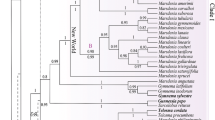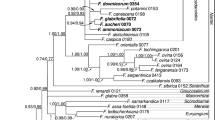Abstract
Reexamining the classification proposed by Hurusawa, the phylogeny of Far EasternEuphorbia subgenusEsula was analyzed using thirteen morphological and seventeen phenolic compound data. These data were analyzed independently and in combination using PAUP under the assumptions of Fitch parsimony. Ten species, comprised of three sections and five subsections within Far EasternEuphorbia subg.Esula and one outgroup from subg.Chamaesyce, were used as terminal taxa. The phylogenetic results did not support the sectional classifications within subg.Esula proposed by Hurusawa. SectionDecussatae was nested in the paraphyletic sectEsula in all of the analyses, and the relationship of sectHelioscopiae was equivocal among data sets. The disagreement of data sets over the placement ofEuphorbia ebracteolata is probably due to a hybrid origin of the species and missing phenolic data forE. pallasii. A sister-group relationship of the Korean endemicE. fauriei with the widespreadE. pekinensis was strongly supported by the morphological and phenolic data.
Similar content being viewed by others
Literature Cited
Ahn B, Lee S, Ro J, Lee K (1995) A chemotaxonomic study on Euphorbiaceae in Korea. Nat Prod Sci 1: 86–98
Baum DA, Small RL, Wendel J (1998) Biogeography and floral evolution of Baobabs (Adansonia, Bombacaceae) as inferred from multiple data sets. Syst Biol 47: 181–207
Boissier PE (1862) Euphorbiaceae, subordo Euphorbieae,In A de Candolle, ed, Prodromus Systematis Naturalis Regni Vegitalis 15(2), Masson and Son, Paris, pp 3–188
Carter S, Radcliffe-Smith A (1988) Euphorbiaceae,In RM Polhill, ed, Flora of Tropical East Africa, AA Balkema, Rotterdam, pp 409–567
Crandall KA, Fitzpatrick JF (1996) Crayfish molecular sys-tematics: using a combination of procedures to estimate phylogeny. Syst Biol 45: 1–26
de Queiroz K (1993) For consensus (sometimes). Syst Biol 42: 368–372
de Queiroz A, Donoghue MJ, Kim J (1995) Separate versus combined analysis of phylogenetic evidence. Annu Rev Ecol Syst 26: 657–681
Felsenstein J (1985) Confidence limits on phylogenies: an approach using the bootstrap. Evolution 39: 783–791
Forster PI (1994) Revision ofEuphorbia plumerioides Teijsm. ex Hassk. (Euphorbiaceae) and allies. Aus-trobaileya 4: 245–264
Hurusawa I (1940) Species generis Euphorbiae Imperii Japonici (I). J Jap Bot 16: 330–346
Hurusawa I (1954) Eine nochmalige Durchsicht des herkommlichen Systems der Euphorbiaceen im weit-eren Sinne. J Fac Sci Univ Tokyo III. 6: 210–341
Khan MS (1964) Taxonomic revision ofEuphorbia in Turkey. Notes Royal Bot Card 25: 71–161
Kitching IJ, Forey PL, Humphries CJ, William DM (1998) Cladistics: the theory and practice of parsimony analysis. Oxford University Press, Oxford
Kuzmanov B (1964) On the origin of Euphorbia subg.Esula in Europe (Euphorbiaceae). Blumea 12: 369–379
Ma JS, Wu CY (1992) A synopsis of ChineseEuphorbia L. s. I. (Euphorbiaceae). Collect Bot 21: 97–120
Molero J, Rovira AM (1992)Euphorbia L. subsect.Esula (Boiss.) Pax in the Iberian Peninsula. Leaf surface, chromosome numbers and taxonomic treatment. Collect Bot 21: 121–181
Normark BB, Lanteri AA (1998) Incongruence between morphological and mitochondrial-DNA characters suggests hybrid origins of parthenogenetic weevil lineages (genusAramigus). Syst Biol 47: 475–494
Park K (1998) Monograph ofEuphorbia sect.Tithymalopsis (Euphorbiaceae). Edinb J Bot 55: 161–208
Park K, Lee S (1988) A palynotaxonomic study of the Korean Euphorbiaceae. Kor J Plant Tax 18: 69–94
Prokhanov Yl (1949) Euphorbia L,In Komarov, ed, Flora URSS, Vol 14. pp 304–495
Schilling EE, Panero JL (1996) Phylogenetic reticulation in subtribe Helianthinae. Am J Bot 83: 939–948
Swofford DL (1991) PAUP, Phylogenetic Analysis Using Parsimony, version 3.0s, Illinois Natural History Survey, Champaign
Webster GL (1967) The genera of Euphorbiaceae in the southeastern United States. J Arnold Arbor 48: 303–430
Author information
Authors and Affiliations
Corresponding author
Rights and permissions
About this article
Cite this article
Park, KR., Ahn, BT. & Lee, KS. Reexamination of sectional classification in far easternEuphorbia subgenusEsula (Euphorbiaceae) using morphological and phenolic data. J. Plant Biol. 42, 199–204 (1999). https://doi.org/10.1007/BF03030479
Received:
Accepted:
Issue Date:
DOI: https://doi.org/10.1007/BF03030479




